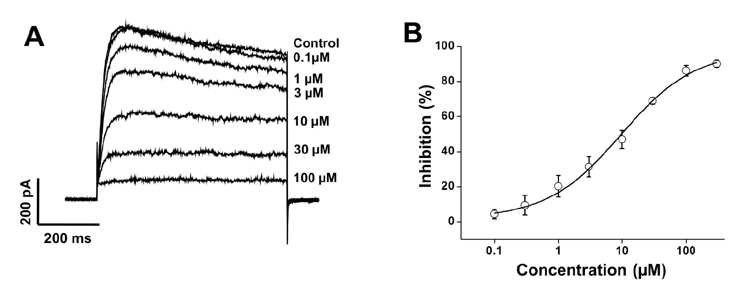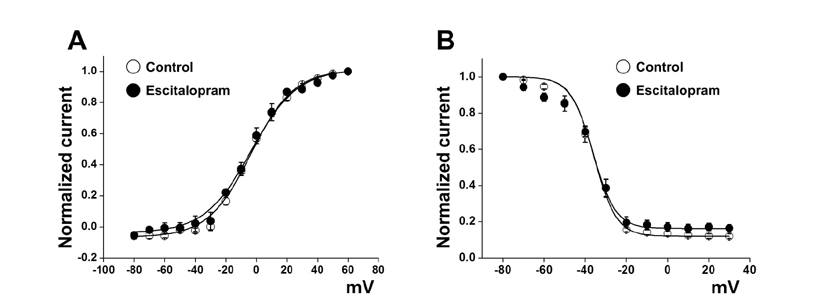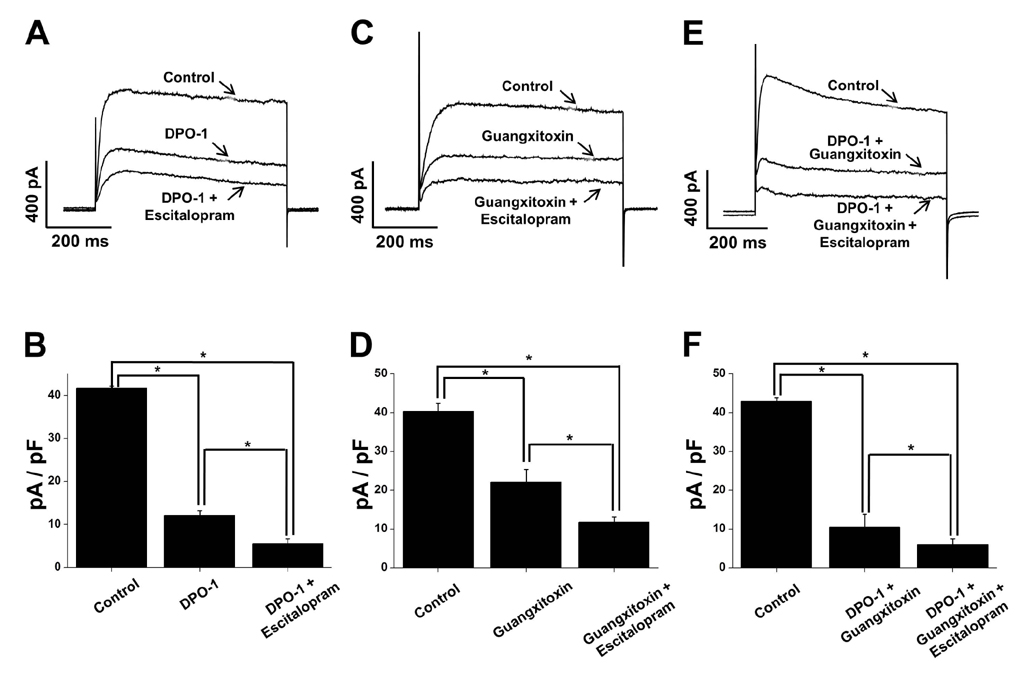Korean J Physiol Pharmacol.
2017 Jul;21(4):415-421. 10.4196/kjpp.2017.21.4.415.
Escitalopram, a selective serotonin reuptake inhibitor, inhibits voltage-dependent Kâ» channels in coronary arterial smooth muscle cells
- Affiliations
-
- 1Department of Physiology, Kangwon National University School of Medicine, Chuncheon 24341, Korea. parkws@kangwon.ac.kr
- 2Department of Molecular and Cellular Biochemistry, Kangwon National University School of Medicine, Chuncheon 24341, Korea.
- 3Department of Medical Environmental Biology and Tropical Medicine, Kangwon National University School of Medicine, Chuncheon 24341, Korea.
- 4Department of Internal Medicine, Kangwon National University School of Medicine, Chuncheon 24341, Korea.
- 5Department of Microbiology, Inje University College of Medicine, Busan 47392, Korea.
- 6Department of Applied Research, National Marine Biodiversity Institute of Korea, Seocheon 33662, Korea.
- KMID: 2384455
- DOI: http://doi.org/10.4196/kjpp.2017.21.4.415
Abstract
- We investigated the inhibitory effect of escitalopram, a selective serotonin reuptake inhibitor (SSRI), on voltage-dependent K⺠(Kv) channels in freshly separated from rabbit coronary arterial smooth muscle cells. The application of escitalopram rapidly inhibited vascular Kv channels. Kv currents were progressively inhibited by an increase in the concentrations of escitalopram, suggesting that escitalopram inhibited vascular Kv currents in a concentration-dependent manner. The ICâ‚…â‚€ value and Hill coefficient for escitalopram-induced inhibition of Kv channels were 9.54±1.33 µM and 0.75±0.10, respectively. Addition of escitalopram did not alter the steady-state activation and inactivation curves, suggesting that the voltage sensors of the channels were not affected. Pretreatment with inhibitors of Kv1.5 and/or Kv2.1 did not affect the inhibitory action of escitalopram on vascular Kv channels. From these results, we concluded that escitalopram decreased the vascular Kv current in a concentration-dependent manner, independent of serotonin reuptake inhibition.
Keyword
MeSH Terms
Figure
Cited by 2 articles
-
Inhibitory effects of the atypical antipsychotic, clozapine, on voltage-dependent K+ channels in rabbit coronary arterial smooth muscle cells
Minji Kang, Ryeon Heo, Seojin Park, Seo-Yeong Mun, Minju Park, Eun-Taek Han, Jin-Hee Han, Wanjoo Chun, Kwon-Soo Ha, Hongzoo Park, Won-Kyo Jung, Il-Whan Choi, Won Sun Park
Korean J Physiol Pharmacol. 2022;26(4):277-285. doi: 10.4196/kjpp.2022.26.4.277.Inhibition of voltage-dependent K+ channels by antimuscarinic drug fesoterodine in coronary arterial smooth muscle cells
Seojin Park, Minji Kang, Ryeon Heo, Seo-Yeong Mun, Minju Park, Eun-Taek Han, Jin-Hee Han, Wanjoo Chun, Hongzoo Park, Won Sun Park
Korean J Physiol Pharmacol. 2022;26(5):397-404. doi: 10.4196/kjpp.2022.26.5.397.
Reference
-
1. Garnock-Jones KP, McCormack PL. Escitalopram: a review of its use in the management of major depressive disorder in adults. CNS Drugs. 2010; 24:769–796.2. Waugh J, Goa KL. Escitalopram: a review of its use in the management of major depressive and anxiety disorders. CNS Drugs. 2003; 17:343–362.3. Bolton JM, Sareen J, Reiss JP. Genital anaesthesia persisting six years after sertraline discontinuation. J Sex Marital Ther. 2006; 32:327–330.4. Chae YJ, Jeon JH, Lee HJ, Kim IB, Choi JS, Sung KW, Hahn SJ. Escitalopram block of hERG potassium channels. Naunyn Schmiedebergs Arch Pharmacol. 2014; 387:23–32.5. Haddy FJ, Vanhoutte PM, Feletou M. Role of potassium in regulating blood flow and blood pressure. Am J Physiol Regul Integr Comp Physiol. 2006; 290:R546–R552.6. Wulff H, Zhorov BS. K+ channel modulators for the treatment of neurological disorders and autoimmune diseases. Chem Rev. 2008; 108:1744–1773.7. Ko EA, Han J, Jung ID, Park WS. Physiological roles of K+ channels in vascular smooth muscle cells. J Smooth Muscle Res. 2008; 44:65–81.8. Nelson MT, Quayle JM. Physiological roles and properties of potassium channels in arterial smooth muscle. Am J Physiol. 1995; 268:C799–C822.9. Lee HM, Hahn SJ, Choi BH. Blockade of Kv1.5 channels by the antidepressant drug sertraline. Korean J Physiol Pharmacol. 2016; 20:193–200.10. Lee HM, Hahn SJ, Choi BH. Blockade of Kv1.5 by paroxetine, an antidepressant drug. Korean J Physiol Pharmacol. 2016; 20:75–82.11. Shimoda LA, Sylvester JT, Sham JS. Inhibition of voltage-gated K+ current in rat intrapulmonary arterial myocytes by endothelin-1. Am J Physiol. 1998; 274:L842–L853.12. Bae YM, Kim A, Kim J, Park SW, Kim TK, Lee YR, Kim B, Cho SI. Serotonin depolarizes the membrane potential in rat mesenteric artery myocytes by decreasing voltage-gated K+ currents. Biochem Biophys Res Commun. 2006; 347:468–476.13. Xu R, Cao M, Wu X, Wang X, Ruan L, Quan X, Lü C, He W, Zhang C. Kv1.3 channels as a potential target for immunomodulation of CD4+ CD28null T cells in patients with acute coronary syndrome. Clin Immunol. 2012; 142:209–217.14. Zhuang GQ, Wu W, Liu F, Ma JL, Luo YX, Xiao ZX, Liu Y, Wang W, He Y. SNAP-25(1-180) enhances insulin secretion by blocking Kv2.1 channels in rat pancreatic islet beta-cells. Biochem Biophys Res Commun. 2009; 379:812–816.15. Snyders DJ, Yeola SW. Determinants of antiarrhythmic drug action. Electrostatic and hydrophobic components of block of the human cardiac hKv1.5 channel. Circ Res. 1995; 77:575–583.16. Lee HA, Hyun SA, Park SG, Kim KS, Kim SJ. Comparison of electrophysiological effects of calcium channel blockers on cardiac repolarization. Korean J Physiol Pharmacol. 2016; 20:119–127.17. Park WS, Ko JH, Kim N, Son YK, Kang SH, Warda M, Jung ID, Park YM, Han J. Increased inhibition of inward rectifier K+ channels by angiotensin II in small-diameter coronary artery of isoproterenol-induced hypertrophied model. Arterioscler Thromb Vasc Biol. 2007; 27:1768–1775.18. Höschl C, Svestka J. Escitalopram for the treatment of major depression and anxiety disorders. Expert Rev Neurother. 2008; 8:537–552.19. Sung DJ, Noh HJ, Kim JG, Park SW, Kim B, Cho H, Bae YM. Serotonin contracts the rat mesenteric artery by inhibiting 4-aminopyridine-sensitive Kv channels via the 5-HT2A receptor and Src tyrosine kinase. Exp Mol Med. 2013; 45:e67.20. Neumeister A. Tryptophan depletion, serotonin, and depression: where do we stand? Psychopharmacol Bull. 2003; 37:99–115.21. Fujii M, Hayashi K, Ohya S, Yamamura H, Imaizumi Y. New screening system for selective blockers of voltage-gated K+ channels using recombinant cell lines dying upon single action potential. J Pharmacol Sci. 2013; 123:147–158.22. Thériault O, Poulin H, Beaulieu JM, Chahine M. Differential modulation of Nav1.7 and Nav1.8 channels by antidepressant drugs. Eur J Pharmacol. 2015; 764:395–403.23. Zhan XQ, He YL, Yao JJ, Zhuang JL, Mei YA. The antidepressant citalopram inhibits delayed rectifier outward K+ current in mouse cortical neurons. J Neurosci Res. 2012; 90:324–336.24. Lee HM, Hahn SJ, Choi BH. Open channel block of Kv1.5 currents by citalopram. Acta Pharmacol Sin. 2010; 31:429–435.25. Kim HS, Li H, Kim HW, Shin SE, Choi IW, Firth AL, Bang H, Bae YM, Park WS. Selective serotonin reuptake inhibitor sertraline inhibits voltage-dependent K+ channels in rabbit coronary arterial smooth muscle cells. J Biosci. 2016; 41:659–666.26. Hong DH, Li H, Kim HS, Kim HW, Shin SE, Jung WK, Na SH, Choi IW, Firth AL, Park WS, Kim DJ. The effects of the selective serotonin reuptake inhibitor fluvoxamine on voltage-dependent K+ channels in rabbit coronary arterial smooth muscle cells. Biol Pharm Bull. 2015; 38:1208–1213.27. Xu C, Lu Y, Tang G, Wang R. Expression of voltage-dependent K+ channel genes in mesenteric artery smooth muscle cells. Am J Physiol. 1999; 277:G1055–G1063.28. Yuan XJ, Wang J, Juhaszova M, Golovina VA, Rubin LJ. Molecular basis and function of voltage-gated K+ channels in pulmonary arterial smooth muscle cells. Am J Physiol. 1998; 274:L621–L635.
- Full Text Links
- Actions
-
Cited
- CITED
-
- Close
- Share
- Similar articles
-
- Selective serotonin reuptake inhibitor escitalopram inhibits 5-HT₃ receptor currents in NCB-20 cells
- Nortriptyline, a tricyclic antidepressant, inhibits voltage-dependent K+ channels in coronary arterial smooth muscle cells
- Inhibition of voltage-dependent K⺠current in rabbit coronary arterial smooth muscle cells by the class Ic antiarrhythmic drug propafenone
- Encainide, a class Ic anti-arrhythmic agent, blocks voltage-dependent potassium channels in coronary artery smooth muscle cells
- Wide Spectrum of Inhibitory Effects of Sertraline on Cardiac Ion Channels





